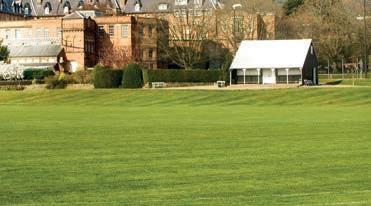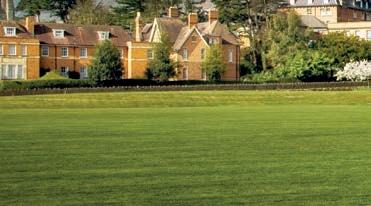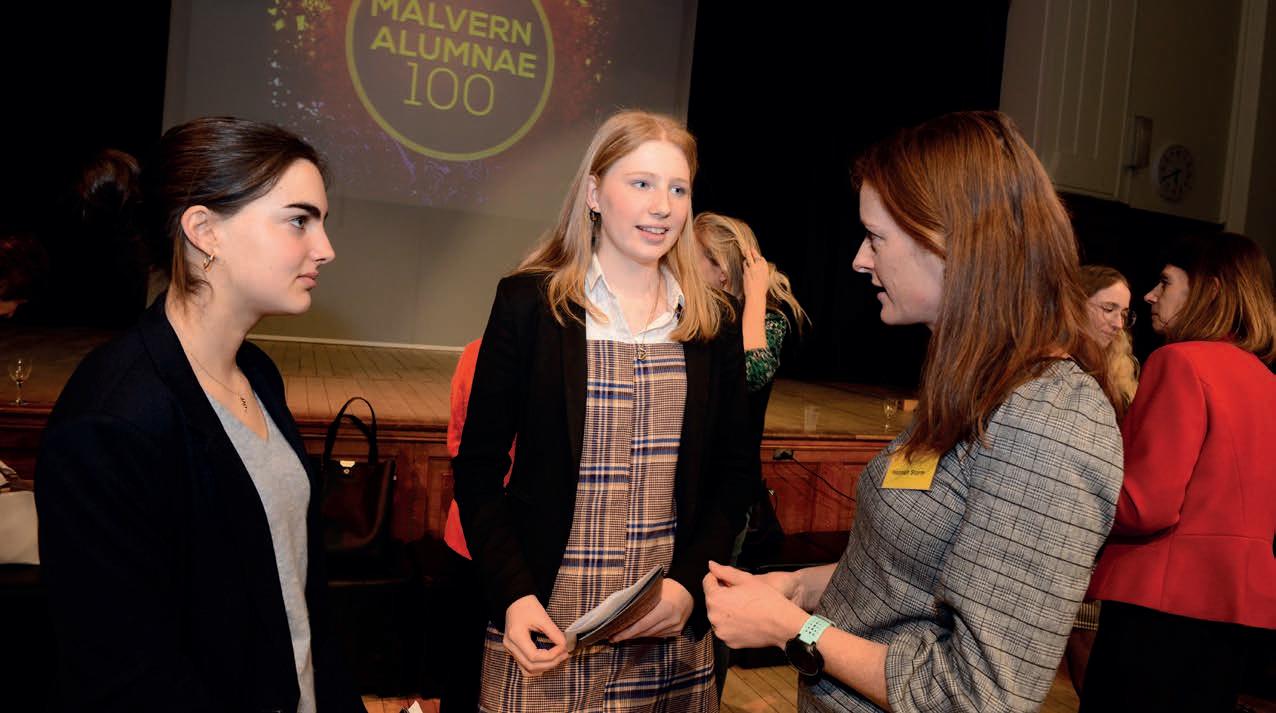
9 minute read
A Seamless and Happy Union Malvern
A SEAMLESS AND HAPPY UNION
Photos by Malvern St James
Fiona Meredith describes how she used brand heritage as a marketing tool to promote a sense of a shared past amongst alumnae when four schools merged to become Malvern St James, now one of the UK’s leading girls’ schools.
Malvern St James Girls’ School (MSJ) is a girls’ day and boarding school set at the foot of the majestic Malvern Hills in Worcestershire. If you look at a plaque in the grand doorway that leads into our building, you will see that the school was opened in 2006 by the Duke of Gloucester. This may give the impression that we are a new school, not even into our third decade, but in fact nothing could be further from the truth. Our pedigree goes back to Victorian ngland, to the fi rst cohort of trailbla ing women who founded girls’ schools to provide an education equal to that of the boys’ schools. And our founding schools were some of the biggest and most successful brands of their era.
A changing educational landscape



Independent schools had proliferated in the small spa town of Malvern during the 18th and 19th centuries. In particular, several girls’ schools ourished and gained a reputation across the UK and internationally. Each had a niche, a specialism which gave it its unique identity: Malvern Girls’ College was known for its outstanding science education, St James’s for its grand social connections (Princess Alice, the mother of the aforementioned Duke of Gloucester was educated here), Lawnside for its artistic tradition and association with George Bernard Shaw, and The Abbey School for its music.
Towards the latter part of the twentieth century, the schools landscape started to change. The boys’ schools were increasingly becoming co-ed, whilst some of the girls’ schools who wished to stay girls-only joined forces. In Malvern, the overall number of schools decreased, whilst the si e of the remaining schools increased. This allowed them to offer more in the curriculum, particularly at GCSE and A Level, new and improved facilities, as well as more enrichment and bigger boarding communities with more-exciting schedules of weekend activities.


Four into one
Our founding schools followed this model. In the late ‘70s and ‘90s respectively, The Abbey School and Lawnside became part of St James’s School. In 2006, St James’s and Malvern Girls’ College, both strong brands in their own right with slightly different markets – the former with a very strong day girl market, the latter with a much bigger boarding base – merged to become Malvern St James Girls’ School. The school has gone from strength to strength, with a strong pupil roll and a reputation for excellent value-added attainment, enrichment and pastoral provision.
At the time of the merger, the governors and school management worked incredibly hard to make the union as seamless and happy as possible. Energies were focused on giving pupils and parents reassurance, a warm welcome and an immediate sense of belonging. This was achieved successfully and within a relatively short period of time.
Creating brand heritage
From a marketing and engagement point of view, it has given us an interesting challenge. A new brand was created and it has been our job to create brand heritage and to showcase our


150-year pedigree. Out of every challenge comes a new wave of creativity and fresh perspective; an opportunity to do something different, untethered by the way things have always been done.
And looking at our wider community – our 4,000 strong alumnae network – how would we bring all of these women together? They are a valuable support network: from careers mentoring to volunteering and donating to our bursary fund, they give to our community in so many ways.
When I joined MSJ in 2014, as I got under the skin of the various founding schools, and talked to alumnae, I could see that there were many common threads to the individual schools. In fact, there was much more that united them than separated them. And there was one thing in particular that was the backbone of them all: the aspiration and achievement nurtured by an all-girls’ Malvern education.
As well as bringing the alumnae together through this unifying message, it was also my aim to demonstrate how their school experience related to the modern-day school experience in Malvern St James. Again, there was so much commonality: academic rigour, enrichment, a sense of giving back to the Malvern community, the bonds of a boarding school, grounded-ness, music, drama, sport, non-gendered academic subjects (we have never struggled to get girls doing Maths, Further Maths, Physics etc at A Level).
What I was looking to achieve was straightforward in essence. But what I hadn’t counted on (perhaps naively) was the ingrained competitiveness and tribalism that existed between the schools. After all, for well over a century they had been rivals on the sports fi eld, in debating competitions, in academic prowess and more.
Giving each school an equal stake

To achieve my aims, I needed to create an alumnae society which worked for everyone, where each school had an equal stake and members felt connected to each other and the new school. I also wanted to show current students, parents and prospective parents the pedigree of MSJ.
Brand heritage is important in the independent schools’ sector: a certain part of our audience is buying into that sense of tradition and longevity. It offers reassurance in an increasingly tumultuous world. Our founding schools had been set up by trailblazing women – the innovators and disruptors of their time (Dominic Cummings, eat your heart out!) – the original champions of female equality. This was a story that chimed with the national mood and a story that needed to be told.
Inspiring women
I’ve always loved my job: I am that cliché – ‘a people person’. Maybe it’s my Irish roots, maybe it’s just natural curiosity, but I love to meet people and know their story. So as I settled into my role and met more and more people, I spoke to so many women who I found totally inspiring. That could be because they were the fi rst female Dean of St Bartholomew’s Medical School (Dame Professor Lesley Rees), or because they went from a 30-something housewife to the top of the advertising business in the space of a decade (Gay Haines), or because at the age of 80 they are still doing London-Paris charity cycles to raise money for deserving causes.
None of them were braggers, none of them thought that they were special; in their own words, they just kept at things and embraced a challenge when it was
presented to them. (I think actually they were being very self-deprecating, but this was typical of their style.) And it got me thinking that if I found them inspiring and relatable, then why wouldn’t others, too? These women were a shot of positivethinking, can-do mentality. I liked them and I knew that MSJ students and other Old Girls would too.
And this is how a small seed of an idea turned into the Malvern Alumnae 100 project, for which Malvern St James has just won the Brand Communications and Marketing award in the Independent Schools of the Year Awards 2020.


Malvern Alumnae 100
The ma eup of the alvern lumnae tool for prospective families as they loo hen fi rst started thin ing about is diverse in terms of age range, at our website and then tour the building. it, it was really just a means of telling interests and specialisms, but the philosophy ne gets a real sense of a school’s values, inspirational stories which would have at its centre is female empowerment and its ambition and ethos from the students it resonance with current pupils and past inspirational female role models. rom r produces and how they use their talents. pupils. ut then could see the incidental Caroline ucas , former leader of the t has also had an impact on admissions spin offs these reen arty alvern feedbac girls have stated that they individual stories would tell of our Individual stories irls’ College alumna , ame Clara urse, applied specifi cally because they felt inspired by this campaign. rospective chool’s history, and would tell of our Chairman of C t parents have commented that they didn’t show that an all girls education is all about school’s history ames’s alumna , hyllida loyd, director of ‘ amma realise that had this history. Current pupils refer to it constantly. e are really empowering women ia ’ awnside alumna , to delighted that a small idea to showcase and giving them the confi dence to believe rsula artin, the fi rst female professor in our inspiring alumnae has snowballed and achieve. The project would bind the t ndrew’s niversity’s year history into a major strand of our mar eting and founding schools together in our ld bbey alumna , there is no ‘type’ here. communications strategy. ● irls’ ssociation, ma ing them appreciate There is someone, and a career path, to the many remar able women each indle the interest of every student. t also school produced. t would not only spea demonstrates where a good education to our current community, but also to ta es you. prospective families and the world at large. Powerful engagement
The central element of the project is t has been a powerful engagement tool a permanent exhibition in chool of current students and families have loved our most remar able and talented seeing this living, breathing history of alumnae. upporting this is a programme . t is normal to see parents and girls of uest pea er slots where alumnae and staff, too standing in front of the connect with our girls to do lectures, exhibition boards, eagerly reading about wor shops and mentoring. alumnae. t is also an excellent mar eting FIONA MEREDITH is Director of Development at Malvern St James Girls’ School. She has previously worked as a board director of London marketing agency Foresight, and as Director of European ublicity for the fi lm division of Disney/ Buena Vista.












